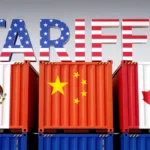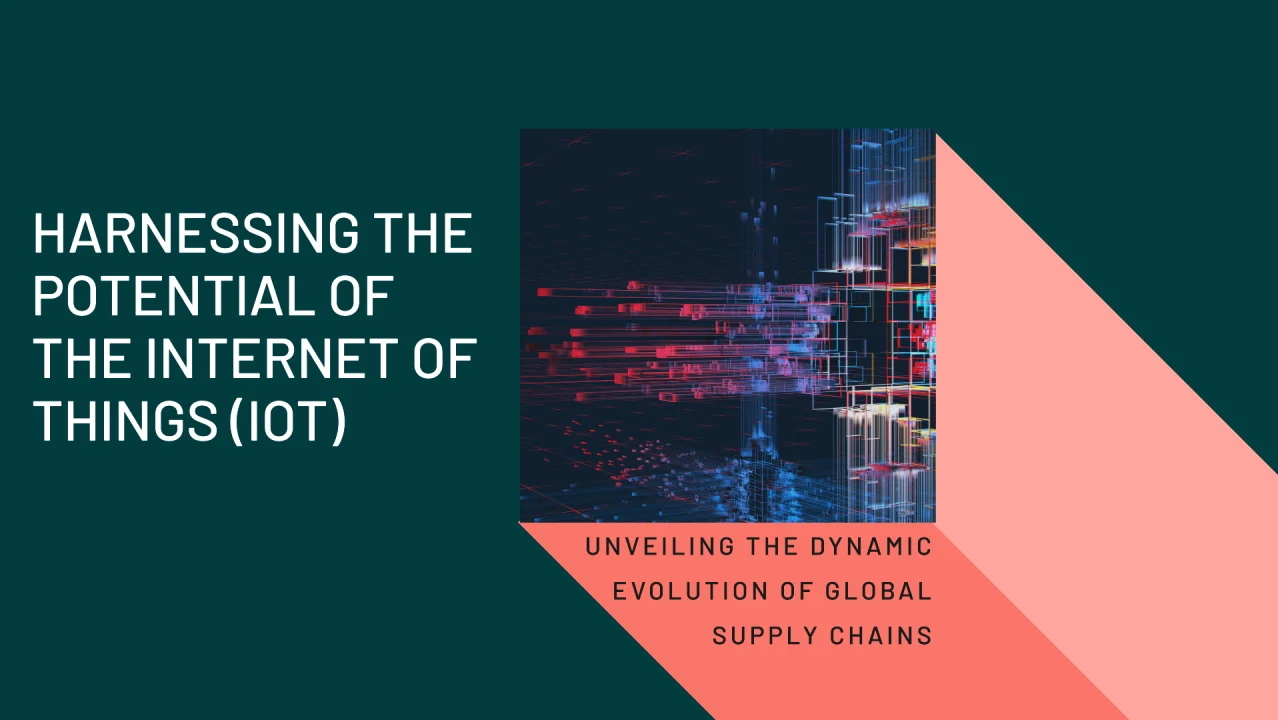Latest Posts
June 30, 2025 Tariffs: The Upside
June 30, 2025
Tariffs: The Upside
June 30, 2025
 Exploring the Role of Intrapreneurs: Innovation Drivers Within Organizations
June 30, 2025
Exploring the Role of Intrapreneurs: Innovation Drivers Within Organizations
June 30, 2025
 Mastering Productivity: A Guide to Being More Effective While Working from Home
Mastering Productivity: A Guide to Being More Effective While Working from Home
Newsletter
Sign up to receive email updates from the Freightpath.
"*" indicates required fields
Unveiling the Dynamic Evolution of Global Supply Chains: Harnessing the Potential of the Internet of Things (IoT)
June 14, 2024
In today’s interconnected world, the global supply chain is the backbone of commerce, facilitating the movement of goods across continents and enabling businesses to reach customers worldwide. However, traditional supply chain management practices often lack real-time visibility, leading to inefficiencies, delays, and increased costs. Enter the Internet of Things (IoT) – a transformative technology poised to revolutionize the way we manage and optimize supply chains on a global scale.
Understanding the Internet of Things (IoT)
At its core, the Internet of Things refers to a network of interconnected devices embedded with sensors, software, and other technologies that enable them to collect and exchange data. These devices, often referred to as “smart” or “connected” devices, can communicate with each other and with central systems over the internet, enabling real-time monitoring, analysis, and control of physical objects and environments.
The Role of IoT in Global Supply Chains
IoT technology holds immense promise for transforming global supply chains by providing unprecedented visibility, transparency, and efficiency. By leveraging IoT devices and sensors throughout the supply chain, businesses can gather real-time data on key metrics such as inventory levels, location tracking, temperature, humidity, and product condition. This data enables stakeholders to make informed decisions, optimize processes, and respond proactively to changing market dynamics and customer demands.
Advantages of IoT in Supply Chain Management
Real-Time Visibility and Tracking
One of the most significant advantages of IoT in supply chain management is the ability to achieve real-time visibility and tracking of goods throughout the entire supply chain journey. By attaching IoT sensors to products, packaging, vehicles, and storage facilities, businesses can monitor the movement, condition, and status of goods in transit. This real-time visibility enables stakeholders to track shipments, identify bottlenecks, and anticipate potential disruptions, thereby improving supply chain efficiency and customer satisfaction.
Predictive Maintenance and Asset Management
IoT-enabled predictive maintenance solutions empower businesses to proactively monitor and manage critical assets such as machinery, vehicles, and infrastructure. By collecting and analyzing data from sensors embedded in equipment, businesses can detect early signs of wear and tear, identify maintenance needs, and schedule repairs before costly breakdowns occur. This proactive approach to asset management minimizes downtime, extends asset lifespan, and optimizes maintenance costs, ultimately enhancing supply chain reliability and productivity.
Inventory Optimization and Demand Forecasting
IoT sensors play a crucial role in optimizing inventory management and demand forecasting in global supply chains. By continuously monitoring inventory levels, shelf life, and consumption patterns in real-time, businesses can accurately forecast demand, prevent stockouts, and minimize excess inventory. IoT-driven inventory optimization solutions leverage advanced analytics and machine learning algorithms to analyze historical data, identify trends, and generate predictive insights, enabling businesses to optimize inventory levels and improve supply chain agility.
Enhanced Safety and Compliance
IoT technology enhances safety and compliance in global supply chains by enabling real-time monitoring and compliance tracking across various regulatory standards and industry guidelines. For example, IoT sensors can monitor temperature-sensitive shipments in the pharmaceutical and food industries, ensuring compliance with temperature control requirements and quality standards. Similarly, IoT-enabled safety solutions can monitor environmental conditions, detect hazardous incidents, and alert stakeholders to take immediate action, thereby minimizing risks and ensuring regulatory compliance.
Supply Chain Collaboration and Integration
IoT facilitates seamless collaboration and integration among supply chain stakeholders, enabling end-to-end visibility and coordination across the entire supply chain ecosystem. By sharing real-time data and insights through IoT-enabled platforms and applications, businesses can collaborate more effectively with suppliers, manufacturers, logistics providers, and customers. This integrated approach to supply chain management enables stakeholders to streamline processes, reduce lead times, and respond rapidly to changing market conditions, thereby enhancing overall supply chain performance and resilience.
Case Studies and Use Cases
Amazon Go
Amazon Go, the cashierless convenience store concept launched by e-commerce giant Amazon, leverages IoT technology to create a seamless and frictionless shopping experience. IoT sensors and computer vision technology track customer movements and product selections, enabling customers to simply grab items off the shelves and walk out of the store without the need for traditional checkout processes. This innovative use of IoT technology not only enhances the customer experience but also provides valuable insights into consumer behavior and inventory management.
Nestlé’s Connected Coolers
Nestlé, the global food and beverage company, utilizes IoT-enabled connected coolers to monitor and optimize beverage distribution in retail stores. These smart coolers are equipped with sensors that collect data on temperature, inventory levels, and consumer interactions in real-time. By analyzing this data, Nestlé gains valuable insights into consumer preferences, product performance, and sales trends, enabling more targeted marketing strategies and inventory replenishment decisions.
Maersk’s Remote Container Management
Maersk, one of the world’s largest shipping companies, employs IoT technology to monitor and manage refrigerated containers (reefers) transporting temperature-sensitive goods such as perishable foods and pharmaceuticals. Maersk’s Remote Container Management (RCM) platform leverages IoT sensors to monitor temperature, humidity, and other environmental conditions inside reefers during transit. This real-time visibility enables Maersk to ensure product quality, compliance with regulatory standards, and timely delivery, thereby enhancing customer satisfaction and trust.
Challenges and Considerations
While IoT holds immense promise for revolutionizing global supply chains, several challenges and considerations must be addressed to realize its full potential:
Data Security and Privacy
The proliferation of IoT devices introduces new security and privacy risks, as these devices collect and transmit sensitive data over networks. Ensuring the security and privacy of IoT data requires robust cybersecurity measures, encryption protocols, access controls, and compliance with data protection regulations such as GDPR (General Data Protection Regulation). Additionally, businesses must implement data governance frameworks and ethical guidelines to safeguard consumer privacy and maintain trust.
Interoperability and Standards
The diverse landscape of IoT devices, protocols, and platforms poses challenges for interoperability and integration across supply chain ecosystems. Standardization efforts and industry consortia are needed to develop interoperability standards, protocols, and best practices for seamless data exchange and collaboration among IoT devices and systems. By establishing common frameworks and open architectures, businesses can overcome interoperability barriers and unlock the full potential of IoT in global supply chains.
Scalability and Complexity
Scaling IoT deployments in large-scale supply chain environments presents technical and operational challenges related to connectivity, data management, and system integration. Managing vast amounts of sensor data generated by IoT devices requires scalable cloud infrastructure, edge computing capabilities, and advanced analytics tools. Additionally, addressing the complexity of IoT deployments, including device provisioning, configuration, and lifecycle management, requires careful planning, resource allocation, and cross-functional collaboration.
Cost and Return on Investment (ROI)
While IoT technology offers numerous benefits for supply chain management, the upfront costs of deploying and maintaining IoT infrastructure can be substantial. Businesses must carefully evaluate the cost-benefit analysis and assess the potential return on investment (ROI) of IoT initiatives. Factors such as hardware and software costs, connectivity fees, ongoing maintenance, and training expenses should be considered when calculating ROI and determining the feasibility of IoT implementations.
Regulatory Compliance and Liability
Compliance with regulatory requirements and liability concerns are important considerations for IoT deployments in global supply chains. Businesses must ensure compliance with data protection regulations, product safety standards, and industry-specific regulations governing the use of IoT devices and data. Additionally, addressing liability issues related to data ownership, data breaches, and third-party liabilities requires clear contractual agreements, insurance coverage, and risk mitigation strategies.
Future Outlook and Conclusion
As we look to the future, the Internet of Things (IoT) will continue to play a pivotal role in transforming global supply chains, driving innovation, and creating new opportunities for businesses to gain a competitive edge. By harnessing the power of IoT technology, businesses can achieve unprecedented visibility, transparency, and efficiency across their supply chain operations.
However, realizing the full potential of IoT in global supply chains requires collaboration, investment, and a strategic approach to address the challenges and considerations outlined above. By overcoming technical, regulatory, and organizational barriers, businesses can unlock new value streams, optimize processes, and deliver superior customer experiences in the digital age.
In conclusion, the Internet of Things (IoT) represents a paradigm shift in how we manage and optimize global supply chains, offering transformative capabilities to drive innovation, agility, and sustainability. By embracing IoT technology and leveraging its potential, businesses can navigate the complexities of modern supply chains, adapt to changing market dynamics, and thrive in an increasingly connected and competitive world.
CEO @ FreightPath Inc. | CSCMP Corporate Member | We Deploy The Industry’s Most Comprehensive Global Supply Chain Curriculum | 500+ Course Library | gofreightpath.com/course-catalog
